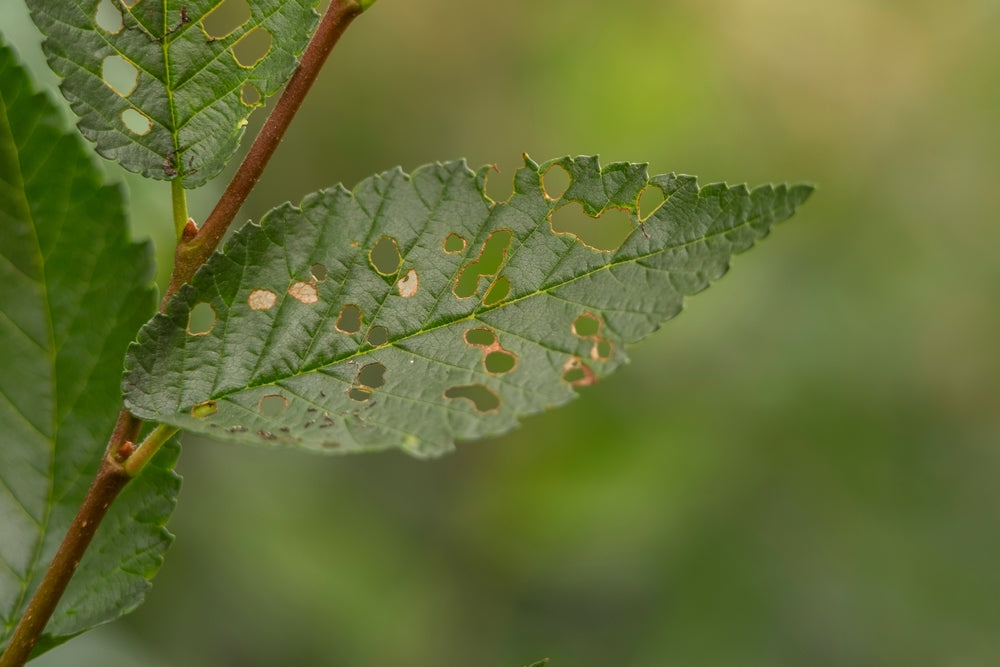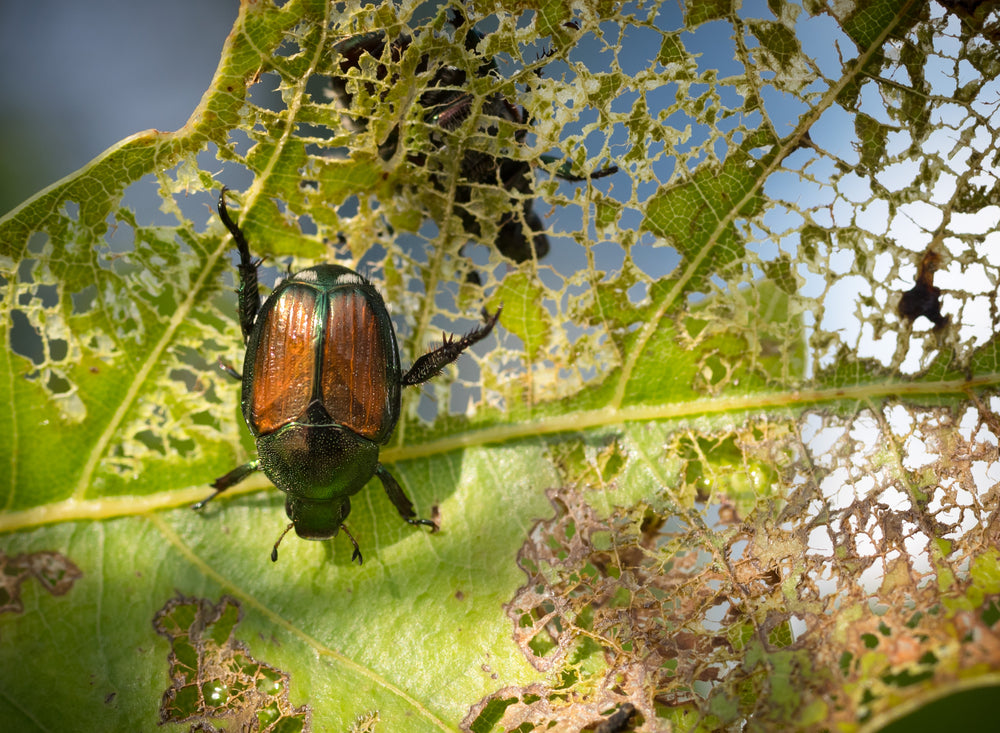
Do you love the shade and beauty trees provide? Keep them happy and healthy by learning how to limit insect infestation on trees in your yard.
By recognizing the signs of insect infestation early, you can take the right steps to control the pests and minimize irreversible damage. Let’s explore the most common tree-killing insects, how to identify them, and which strategies are most effective to protect your trees and provide shade for years to come!
Signs of Insect Infestation on Trees
Detecting tree insect infestation in its early stages will significantly improve your chances of saving the affected trees. While there are several signs, the most obvious indicators often include visible damage.
- Bark Damage: The bark of a tree is often the first sign of trouble beneath the surface. Boring insects will make small, perfectly round holes as they burrow into the tree. This will also sometimes leave a sawdust-like material around the base of the tree or stuck to the bark, and is often a telltale sign of an insect infestation.
- Leaf Damage: Other crucial clues can be found by examining the tree's leaves. Chewed leaf edges, leaves with only the veins left, or ones that are covered in tiny dots indicate insects have been feeding on your trees. Some trees will also lose their leaves in sections or throughout the entire leaf canopy.
- Unusual Growth Patterns: If your trees’ growth is suddenly stunted or wilting, or the branches are dying, it could also indicate an insect infestation. A lot of tree-killing insects leave behind a sticky residue called honeydew, which can lead to mold growth on leaves and branches. Egg masses, cocoons, or webbing within the tree itself are other signs of an active tree insect infestation.
Identifying Common Tree-Killing Insects
Proper tree insects identification is key to solving your insect problem. Here are some of the most common species:
- Bark Beetles: These insects typically attack trees like pine, spruce, or fir. They bore through bark and create complex tunnels beneath the surface. Their feeding affects the tree’s vascular system, causing issues with nutrient and water transport. Signs of a bark beetle infestation include small masses of resin, boring dust, and eventually, needles turning red and then brown.
- Emerald Ash Borer: This metallic green beetle, popular across North America, creates a distinctive D-shaped exit hole in the bark of an infested tree. Other signs of an emerald ash borer include S-shaped tunnels when bark falls away and increased woodpecker activity.
- Gypsy Moth Caterpillars: Known for targeting over 300 tree species, these voracious eaters prefer to snack on oaks and other hardwoods. These hairy caterpillars have blue and red dots along their backs and lay tan-colored egg masses of between 500 and 1,000 eggs on tree trunks and branches.
- Asian Longhorned Beetles: Popular around maple, birch, and elm trees, these large black beetles have white spots and create perfectly round exit holes. Their extensive tunneling weakens branches and stems, eventually causing structural damage, disrupting nutrient flow, and ultimately killing the tree.
The Most Destructive Insects That Kill Trees
Among the most popular tree insects, there are a few species that cause the most devastating impacts on your gorgeous residential landscaping.
This list of tree-killing insects includes:
- Mountain Pine Beetle: The most destructive tree insect in North America, it spreads a fungus that causes blue-stained wood and almost always kills the infected tree.
- Emerald Ash Borer: This beetle’s larvae feed under the bark of a tree, creating galleries that will eventually kill the tree.
- Hemlock Woolly Adelgid: These tiny aphid-like insects extract sap, causing needles to dry out and drop off.
- Spotted Lanternfly: This invasive species feeds on the sap of various trees, including fruit trees, hardwoods, and ornamentals. Its feeding habits weaken the trees.
How to Treat and Protect Trees from Insect Infestations
When dealing with a tree insect infestation, you have to act quickly to save the affected trees and prevent the spread to other nearby trees and shrubs.
For minor infestations, you can physically remove visible insects, egg masses, or affected branches. Pruning and proper disposal of infested material prevent insects from spreading to healthy parts of the tree or neighboring plants.
For serious infestations, Catchmaster® offers tree insect control products to mitigate your issues. Not only will these solutions help stop an insect infestation on trees, but they can also help you detect insect activity before the damage becomes severe. Tree trunk shields capture crawling insects as they move up and down trunks, providing early warning of potential issues and capturing pests before they become a more serious problem.
Preventing Tree Insect Infestations Before They Start
One way to deal with an insect infestation on trees is tree-banding. This particular pest management technique helps to protect trees from insects like the invasive spotted lanternfly.
Catchmaster’s Tree Band Sticky Traps Adhesive Barrier Kit contains everything you need to eliminate dangerous, tree-killing insects. Simply wrap the trunk of your tree with the plastic wrap and spread the non-toxic, weatherproof adhesive along the plastic. As pests and insects walk up and down the tree, they become trapped on the glue, interrupting their breeding cycles and preventing massive insect infestations on trees before they start.
By taking proactive measures and learning how to identify pests, you can effectively safeguard your trees against destructive insects.
Defend Trees from Pests with Catchmaster
Catchmaster’s non-toxic, efficient, and environmentally-friendly solutions will help preserve your trees and keep you in the shade all year long. Our traps have been designed with you in mind. They are low-maintenance, easy to set up, and cost-effective, without sacrificing insect-stopping power™.
When you need to stop an insect infestation on trees, turn to the solutions trusted by the professionals for over 70 years. Become a Catchmaster today!









